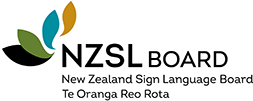Vote on the NZSL name for Whaikaha - Ministry of Disabled People
- Information on how to vote
- What is Whaikaha?
- Background on name
- Whaikaha branding
- How do sign names work?
- NZSL Board Media Release
- te reo Māori
- English
- New Zealand Sign Language (NZSL)
Information on how to vote
Whaikaha wants to respect Deaf culture, so they are asking only Deaf people to vote on the sign name. If you are a member of a Deaf organisation you should be receiving an email from them directly. Alternatively, Deaf people can also complete the Whaikaha NZSL name survey via this link .
The sign name with the most votes will become the official sign name of Whaikaha - Ministry of Disabled People after the final endorsement by the NZSL Board.
Background information
What is Whaikaha?
Whaikaha is a new Ministry set up in partnership with the community and Māori to transform lives.
The purpose of Whaikaha is to deliver much needed change to the lives of Deaf people, disabled people and their whānau through the services and supports it funds, policy work and its role in cross-Government stewardship. All our work is underpinned by obligations to Te Tiriti o Waitangi, NZSL Act, Enabling Good Lives principles and the United Nations Convention on the Rights of Persons with Disabilities.
Whaikaha has a responsibility in this partnership to listen to the voices of the Deaf and disabled community and learn from the process of working together.
Background on name
When the Whaikaha name was first being established, officials, Deaf people and disabled people agreed the name should include te reo Māori, English and New Zealand Sign Language.
The word ‘Whaikaha’ is closely associated with Maaka Tibble, a Ngāti Porou kaumatua, who has worked in the disability community for decades and is a founding member of the Māori Disability Leadership Group. He suggested ‘Whaikaha’ or ‘Tāngata Whaikaha’, which is based on disabled people’s strengths and reflects a positive view of disability.
The English part of the name, ‘Ministry of Disabled People’ was developed through community engagement with Deaf people and disabled people. Many thought it was important the name was clear on what the Ministry was about and wanted it to show that the disabled people would be leaders and partners in the Ministry, rather than it being ‘for’ disabled people, they wanted it to be ‘of’ disabled people.
Whaikaha branding
The kaupapa of Whaikaha is to support disabled communities to flourish and be self-sustaining. A whakatauākī or Māori proverb, was developed with Māori advisors and the community. The inspiration was the Rātā tree, which grows with the support of another tree until it gains the strength to be self-sustaining.
- Me he aka rātā ka tipu, ka puāwau tahi kia tū kaha i ngā hihi ō Tamamuiterā.
- Like the rātā vines growing together and flourishing to stand strong in the warmth of the sun.
There is also a tohu design which is a visual representation of the whakatauākī, reflected through whakarare patterns, a series of parallel lines, with intersecting curved elements. These represent rātā vines connecting and supporting each other as they grow into trees.
How do sign names work?
Sign names are common in the Deaf community and are a strong part of Deaf culture.
Sign names are given by Deaf people to people and places frequently talked about by the Deaf community.
They are given to people or places to represent different factors such as:
- A visual feature or landmark
- Something famous or well known
- Meaning of the word
- Lip pattern
- Fingerspelling
NZSL Board Media Release - Voting opens on NZSL name for Whaikaha - Ministry of Disabled People
The New Zealand Sign Language (NZSL) Board has announced that voting is open on options for the sign name for Whaikaha – Ministry of Disabled People.
|
Whaikaha will be the first ministry in New Zealand to have a name in all three of our official languages.
NZSL Board Chair Rhian Yates, said “Sign names are part of Deaf culture and are gifted by the Deaf community to organisations and people.”
“Three options have been developed by an NZSL expert group with people from NZSL Board, te rōpū Kaitiaki, Deaf Aotearoa, Deaf Action and the Deaf Studies Research Unit (DSRU) at Victoria University of Wellington.
One option reflects the name of Whaikaha, which is based on people’s strengths and means 'to have ability' or 'to be enabled'. The second option uses finger spelling of Whaikaha. The third option represents the logo of Whaikaha, which reflects the rātā tree that grows with the support of another tree until it gains the strength to be self-sustaining and the Ministry’s whakatauki.
“The NZSL Board welcomes all Deaf people to help decide which sign name should be used as the official sign name for Whaikaha. We are respecting Deaf culture by asking only Deaf people to vote.
“Deaf organisations will email members a survey link to vote. This will include the national Deaf Education Centre, Ko Taku Reo, to ensure Deaf students can take part.
“This is a historic moment for Deaf people and for Aotearoa. We encourage Deaf people across the motu to take part in recognising the value of NZSL,” said Rhian Yates.
Voting is open from 8 – 21 June 2023. Deaf people who don’t get a link can email nz_sign_language@whaikaha.govt.nz to take part.
ENDS
About the NZSL Board
The purpose of the NZSL Board is to promote and maintain NZSL by ensuring the development, preservation and acquisition of the language, and to provide expert advice to government and the community on NZSL. The NZSL Board has up to 10 members in total, all of whom are NZSL users, and a majority of members are Deaf NZSL users.
Page last updated:
